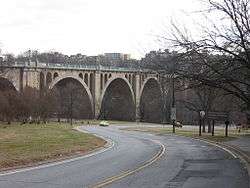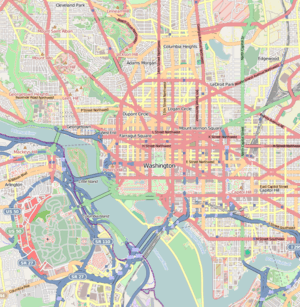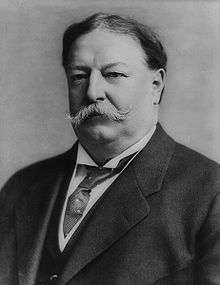Taft Bridge
The Taft Bridge (also known as the Connecticut Avenue Bridge or William Howard Taft Bridge) is a historic bridge located in the Northwest quadrant of Washington, D.C.. It carries Connecticut Avenue over the Rock Creek gorge, including Rock Creek and the Rock Creek and Potomac Parkway, connecting the neighborhoods of Woodley Park and Kalorama. It is named after former United States president and Supreme Court Chief Justice William Howard Taft, and sits to the southwest of the Duke Ellington Bridge.[2][3]
William Howard Taft Bridge | |
 | |
 | |
| Location | Connecticut Avenue, NW over Rock Creek Washington, D.C. |
|---|---|
| Coordinates | 38°55′14″N 77°2′59″W |
| Built | 1907 |
| Architect | George S. Morison Edward Pearce Casey |
| Architectural style | Classical Revival |
| NRHP reference No. | 03000584[1] |
| Added to NRHP | July 3, 2003[2] |

Four statues of lions by sculptor Roland Hinton Perry, known as the Perry Lions, are placed in pairs at both ends of the bridge. On July 3, 2003, the Taft Bridge was added to the National Register of Historic Places.[1]
History
The Classical Revival bridge was built from 1897 to 1907. It was designed by engineer George S. Morison and architect Edward Pearce Casey.[2][3] It is an arch bridge with unreinforced concrete arches and a reinforced concrete deck. The total length of the bridge is 274.5 meters (901 ft). It has been called an "engineering tour de force" and the largest unreinforced concrete structure in the world.[4] In 1931, the bridge was renamed in honor of U.S. President William Howard Taft, who frequently walked the bridge while Chief Justice of the United States.[5]
During early planning for the Washington Metro in the 1960s, the Red Line was slated to run across the bridge to connect Dupont Circle and Woodley Park. Instead, the metro was built underground.[6]
Perry Lions
The bridge is "guarded" by four large male lions, two on each end of the bridge (each approx. 7 ft. x 6 ft. 6 in. x 13 ft.). Two of the lions rest on all fours with their heads tilted upwards and mouths slightly open while the other pair lie with their eyes closed, apparently sleeping. They were originally designed and sculpted by Roland Hinton Perry in 1906 out of cast concrete (the bridge as a whole is one of the first cast concrete bridges in the country) and were installed in 1907.
In 1964 the lions were restored and weatherproofed by Washington-based sculptor Renato Luccetti, although this restoration proved to be less than entirely successful. When a major rehabilitation of the bridge began in 1993, the lions, which were in very bad condition, were removed for further restoration. They are currently stored in the Air Rights Tunnel on southbound I-395. The sculptures were finally found to be beyond restoring.[7][8]
The United States Commission of Fine Arts worked with the city in the late 1990s to oversee the production of the replacement lions that now sit on the bridge. The sculptor Reinaldo Lopez-Carrizo of Professional Restoration produced molds based on the existing sculptures and photographs, and used them to cast new concrete lion sculptures that were installed on the bridge in July and August 2000.[9] The same molds were used to cast bronze lions installed at the main pedestrian entrance to the National Zoo farther north on Connecticut Avenue in 2002.[10] The white lion in the lobby of the U.S. Commission of Fine Arts is a quarter-size replica from that effort.[11]
Bairstow Eagle Lampposts
Twenty-four lampposts are equally spaced along both sides of the Taft Bridge. Created by sculptor Ernest Bairstow in 1906 ,the lampposts are composed of concrete bases (about 5 feet high, 8 inches deep and four feet wide) with painted iron lampposts (about 17 feet high and 4 wide) set in them. The pedestals are decorated with garland and a fluted column featuring acanthus leaves at the top and bottom. Above the leaves is a horizontal bracket with two globes hanging from each side of the column. Each lamppost is topped with a painted iron eagle with its wings spread.[12]
A replica of the Bairstow eagles is seen in a World War I monument in Middletown, Delaware.[13]
Gallery
- Eagle Lampposts
- Eagle Lampposts
- Bridge from the south with Lampposts
 Perry Lion at the Bridge
Perry Lion at the Bridge- Full length view of a Perry Lion
 Lion at the National Zoo
Lion at the National Zoo Lion at the National Zoo
Lion at the National Zoo
See also
- List of bridges documented by the Historic American Engineering Record in Washington, D.C.
- List of bridges on the National Register of Historic Places in Washington, D.C.
- National Register of Historic Places listings in the District of Columbia
References
- "Weekly List of Actions Taken on Properties: 6/30/03 through 7/05/03". National Park Service. July 11, 2003. Retrieved July 16, 2009.
- "National Register Information System". National Register of Historic Places. National Park Service. March 13, 2009.
- "District of Columbia - Inventory of Historic Sites" (PDF). Government of the District of Columbia. September 1, 2004. Archived from the original (PDF) on June 18, 2009. Retrieved July 16, 2009.
- Donald Beekman Myer; Abba G. Lichtenstein (1996). "Washington, a City of Beautiful Bridges: Paradigms to Emulate". United States National Research Council: 18–34. ISSN 0361-1981. Cite journal requires
|journal=(help) - Pringle, Henry F. (1939). The Life and Times of William Howard Taft: A Biography. 2 (2008 reprint ed.). Newtown, CT: American Political Biography Press. pp. 963–964, 1072. ISBN 978-0-945707-19-6.
- Myers, Aaron. "Never Built: Metro's Bridge Over Rock Creek". Ghosts of DC. Retrieved 10/2/13. Check date values in:
|accessdate=(help) - "Perry Lions, (sculpture)".
- "Roar Restored, Lions to Rule Bridge Again". 2000-07-18. Retrieved 2019-08-24.
- "Professional Restoration---Taft Bridge Lions Project".
- "Archived copy". Archived from the original on 2012-10-05. Retrieved 2011-02-07.CS1 maint: archived copy as title (link)
- Theresa Vargas (2019-08-31). "Is a giant lion statue being stored under a D.C. tunnel? I decided to find out". The Washington Post. Retrieved 2019-08-31.
- Save Outdoor Sculptures! (1993). "Bairstow Eagle Lampposts (sculpture)". SOS!. Smithsonian. Retrieved 5 May 2010.
- Al Kemp (2008). "Eagle eyes a must to notice swap". News. The News Journal. Retrieved 1 Feb 2011.
Further reading
- J. Goode, Washington Sculpture, The Johns Hopkins University Press, 2008. ISBN 0-8018-8810-7, A cultural history of outdoor sculpture in the Nation's capital.
- Williams, Paul K., Gregory J. Alexander, & Gregory V. Alexander. Woodley Park Arcadia Publishing, 2003. ISBN 0-7385-1508-6
External links
| Wikimedia Commons has media related to Taft Bridge. |
- Historic American Engineering Record (HAER) No. DC-6, "Connecticut Avenue Bridge"
- Taft Bridge at Structurae
- 1911 Postcard of Connecticut Avenue Bridge - Ghosts of DC blog
